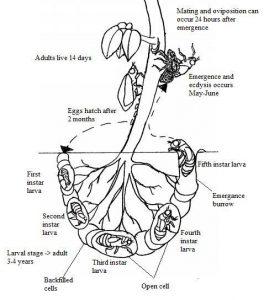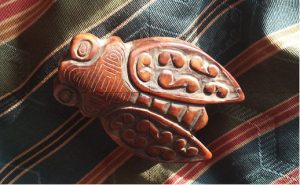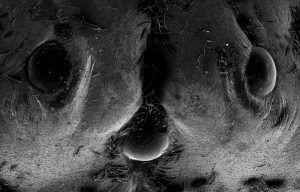
By Sarah Schulz-Arnold
The sweet summer song of the annual cicada annual cicada is one I long to hear, especially when I’m reaching for the snow shovel. That is precisely what I was doing when I found the camouflage-colored body of an annual cicada on my garden shed window. I make it a point to not bumble around the shed much in the winter months as it makes the pangs for a green garden only stronger. This little corpse on my shed windowsill sparked a different kind of melancholy. She had made it to adulthood only to be trapped in my shed when it emerged, spending her whole adult life trying to get out and sing the song of her people and make more of her own kind.
I identified my auto-taxidermied little friend as as Tibicen canicularis, more commonly known as the annual (refers to their appearance, rather than their lifespan) Dog Day cicada. These cicadas are not the periodic cicadas that seem to blanket the trees every seventeen years. They have a much shorter larvaehood of three to four years, which would help explain how the poor dear ended up in my shed. In 2012, Hurricane Sandy up-ended the garden shed onto our cars. It is a very light weight shed made of metal siding, so it was easy enough to tip it back on to the foundation. However, we couldn’t get it exactly back to where it was as it bent a bit. Next to the shed are my hazelnut shrubs and a goji berry vine. It would have been on one of the branches of these shrubs that our little friend would have been laid as an egg, burrowed under once hatched, and then emerged from last summer…right into my shed as it was off the foundation and partially covering the roots of the hazels.

What is the purpose of the cicada then, if only to come out to mate for two weeks and then die of a combination of starvation and dehydration? Aside from keeping the population going, they provide a very important infusion of carbon and nitrogen further up the food pyramid without upsetting the base. Trees and shrubs take carbon dioxide, sun, and water and make sugar for themselves. Cicadas feed from the uptake of water (through the xylem vascular tissue) which has very little sugar to it at all. When the larva has finally managed to glean enough resources to get it to adulthood 3-4 years later, it emerges from the ground in its last larval stage that looks like its adult form without wings. From that molts the adult that hopefully manages to breed before being eaten by a bird or any number of predators. Those predators are eaten by larger predators and so on and so forth.

The life cycle of the cicada is a patient one. The eggs are laid on a tree branch or trunk where they hatch into first instar larvae and fall to the ground. The larvae then burrow under the leaf litter to start a slow journey through the root system of the tree it initially fell from, back to the trunk of the tree to live its adult life for two whole weeks. As it digs deeper, it has nowhere to go with the soil it has dug, so the cicada keeps back filling the hole behind it. The larval cicada will start its dig upwards after the third instar stage so that by the time it molts into its fifth larval stage, it will be right by the surface of the ground so that it may molt and begin the cycle again with its own offspring. With such an unusual life cycle that is only visible above ground (unless you dig them up) , they have managed to tickle human curiosity since history began.

Cicadas are ponderous creatures. It must have seemed very strange to humanity at the start of history how these insects could just emerge out of the ground and then do nothing but sing, dance, and mate without seeming to eat.There is a Greek myth surrounding this odd behavior of the cicada involving the genesis of the Muses. When Apollo had trained once feral forest nymphs in the ways of the arts, they shared their grace with humanity. As the mortal humans had never done anything except to survive, the arts were a great comfort and joy to them. However there were some men that were so obsessed with the music and stories, they were overtaken by a mania so strong that they sang and danced all day, not noticing the needs of the body until they died. The Muses were impressed, so they brought these devotees back as cicadas to watch humanity to see if they were being honored so that the faithful could be rewarded in kind.The cicada’s triad of amber-colored ocelli (simple light-sensing eyes) even seem to honor the leader of the Muses as she was said to wear gold on her brow. Cicadas came to represent renewal and ascension of the spirit to the Greeks as well as being considered a delicacy right after the last molt.

Chinese Feng Shui practices saw the cicada as a symbol of rebirth as most of the Asian-originating religions believe in reincarnation. The dictates of Feng Shui say a carved jade cicada should be placed at the foot of the bed, or as beads in the mouth of a dying person as a wish for a good rebirth. Another use a representation of a cicada could serve is as a gift to a person who is about to undergo a very big change in life like graduation or starting a new job to ensure that the transition goes smoothly. The folklore was passed on by farmers who believed that cicadas would change their song when bad storms were coming as a warning to prepare for the worst.
With all the environmental good and rich cultural heritage that cicadas passively are a part of, I know that I will be paying more attention to my shed to make sure that no other suffers my little buddy’s fate. At the very least, I’m giving a blue jay a chance at a nutritious lunch. But more likely I hope to hear the song of the cicada’s children for many years to come.

When I was a child, I knew that this triad of bumps were eyes and I always wanted to see them closer to find out what they see with them. The notion is that all flying insects that have these use them to triangulate in flight. Cicadas have some of the most prominent ocelli that resemble amber gems on their brow and getting to see these under a scanning electron microscope has been a childhood dream of mine come true.